For many women, the kitchen is the place where they spend most of their time at home. And creating comfort and coziness around it greatly influences the desire to be there. Hand-made useful items and accessories allow you not only to save on buying new attributes, but also to sew them individually for yourself.
What is this?
Potholders are an indispensable thing in the kitchen, which need to be changed from time to time. There is more than one technology for creating a convenient mitten. What to sew a potholder from can be found in any closet - these can be scraps of unnecessary fabric or denim.
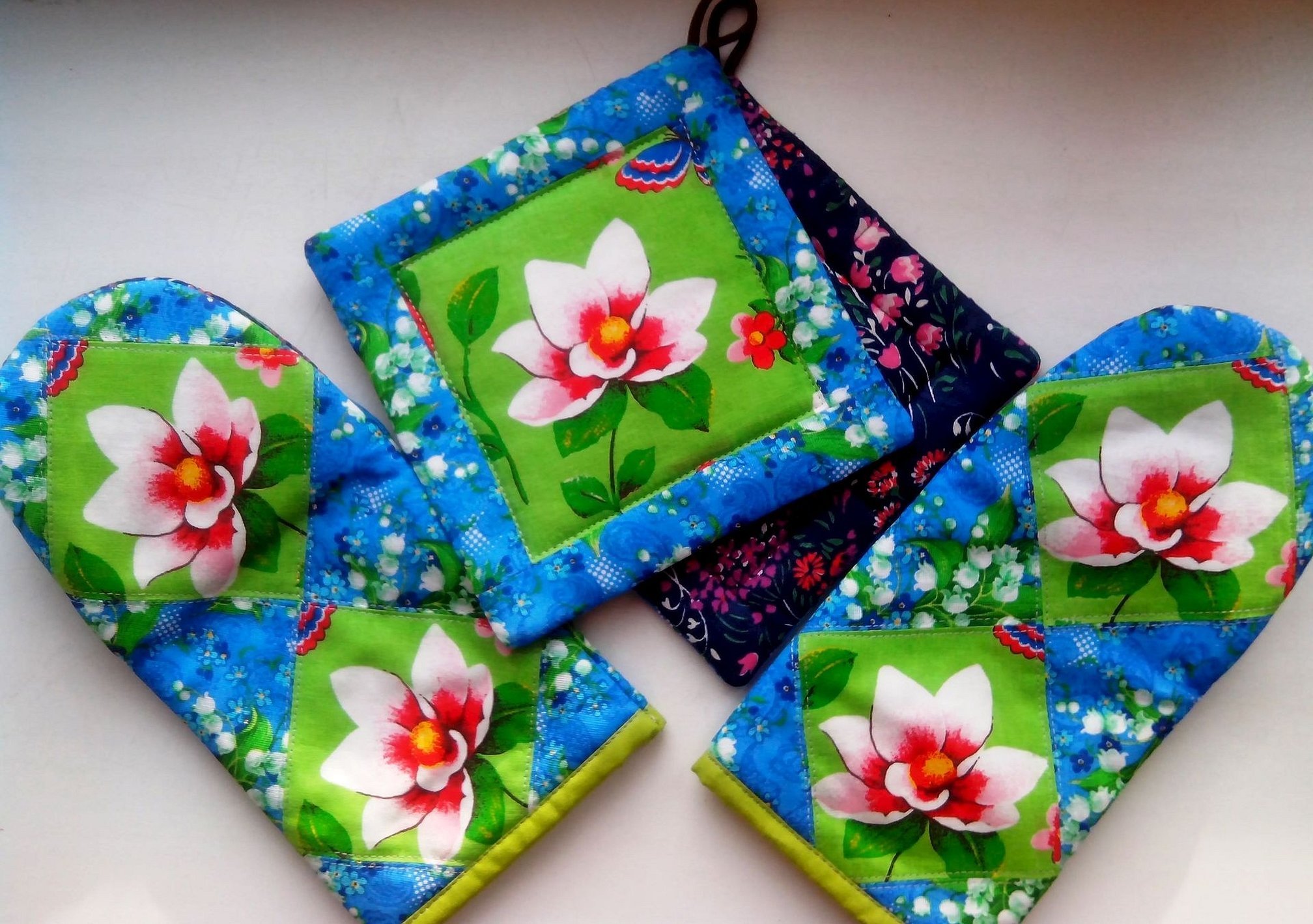
Benefits of use
A potholder is a handy kitchen accessory used when preparing hot food, allowing you to protect your hands from burns. With its help, you can hold a hot baking sheet in the oven to check the readiness of the dish, remove a frying pan from the stove or a saucepan, press the lid and drain the water into the sink so that the potatoes or pasta remain inside. This device is also used as a stand for hot dishes, protecting the work surface from damage.
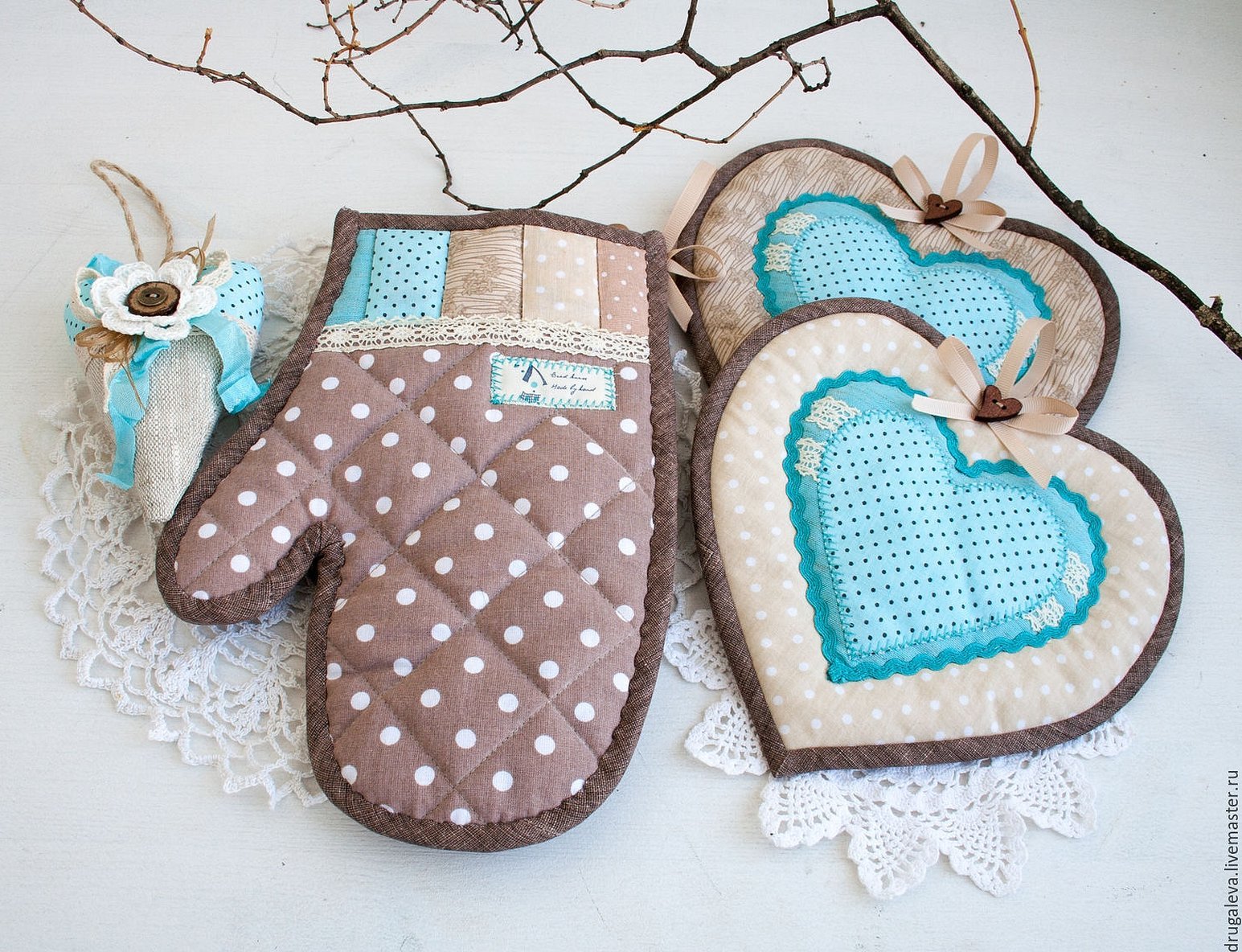
A homemade mitten or rug can be a wonderful decorative accessory that complements the kitchen interior. Due to the variety of shapes and colors, this attribute is also presented as a gift to housewives.
Types of products and their fillers
Regardless of shape, size, color scheme and application features, only two types of potholders are known:
- Textile;
- Silicone.
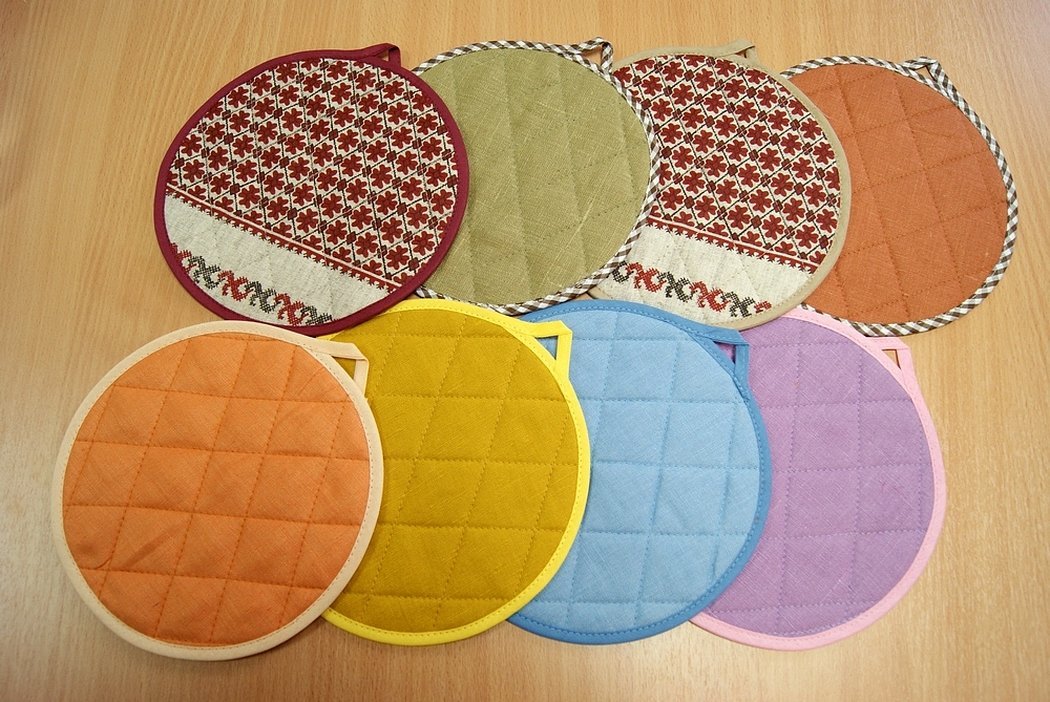
Textile
For fabric potholders, it is best to use material made from natural fibers: cotton, linen or calico fabrics. They are more durable, wear-resistant and can withstand high temperatures well.
Please note! Synthetic fabrics can lose their shape when heated and very quickly become unusable. Plus, synthetics have the property of quickly igniting, so you should be very careful when using a grip made of this material near an open fire.
The following are considered to be the standard for textile potholders:
- Ordinary flat;
- Having the shape of a geometric figure: square, round or rectangular;
- In the form of a mitten.
Filler. It is the key factor in protecting your hands from burns. When choosing a filling, it is best to choose batting or drape, felt and flannel are also sometimes used - it will not be scary to take a hot teapot or saucepan with such a filler.

Important! Potholders with synthetic padding instead of filler increase the risk of getting burns by 3 times, than with drape or batting. If it so happens that this was not detected when buying, then it is best to use it as a decorative accessory.
Silicone
A silicone potholder is a modern approach to creating kitchen utensils. It has a wide functional range and is diverse in design types. It also has a wide range of different shapes: a clamp, a mitten, a glove. Or in the form of animals: cats, a pig, dogs, mice, frogs, butterflies. The technical characteristics of this type of potholders have many positive aspects, which allows them to gain more and more popularity among housewives.
Patterns and diagrams
DIY potholders from scraps: patterns can be found on cutting and sewing websites. As a rule, such resources always have patterns for interesting models of mittens, easy and original technologies for creating beautiful mittens or napkins for the kitchen. Beginner seamstresses are offered master classes and step-by-step instructions to sew a mitten using the correct pattern.
Additional information! Schoolchildren can be involved in such an activity. It will later become their favorite activity. Every girl will enjoy sewing small patches, learning the patchwork technique when creating unusual crafts that can be useful in labor lessons.
Before you start sewing a potholder, you need to make a pattern. You won't have to create any complex designs. Old mittens or ready-made patterns from the Internet will serve as a template. You can draw a square or a circle yourself.
Important! Before sewing, the material must be washed, dried and ironed.
The pattern is transferred to the fabric and carefully drawn. There should be two pieces of the main fabric and two pieces of the filler. Thus, there are four main elements in total. They should be identical and with an additional allowance of 0.7-1 mm along the edges for allowances!
The colorful "Ring"
There is nothing complicated in how to sew a colorful potholder. It is enough to prepare the material and transfer the pattern to the fabric. There should be 4 parts, if desired, a piping is applied along the edges. The manufacturing process exactly repeats the mechanism for creating a "Simple Square".
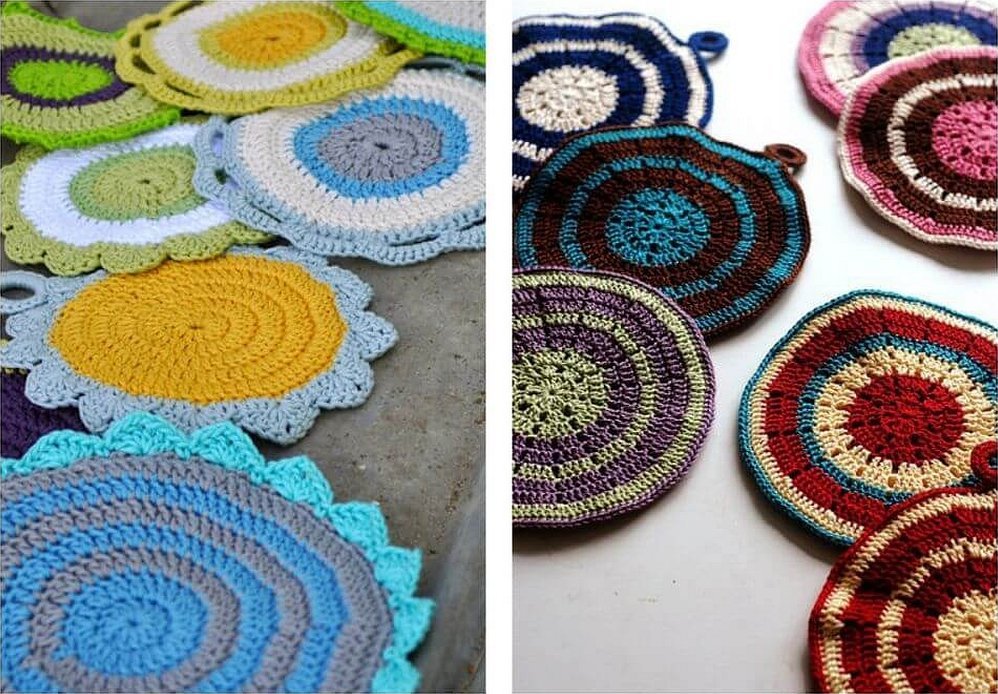
"Simple square"
The pattern of this potholder has the simplest form. Even an inexperienced craftswoman can sew it.
Additional information! If the loop is sewn on the side, the square will automatically become a diamond.
Materials required:
- Fabric for the base,
- Filler,
- Scissors, thread and needle,
- Optional - braid.
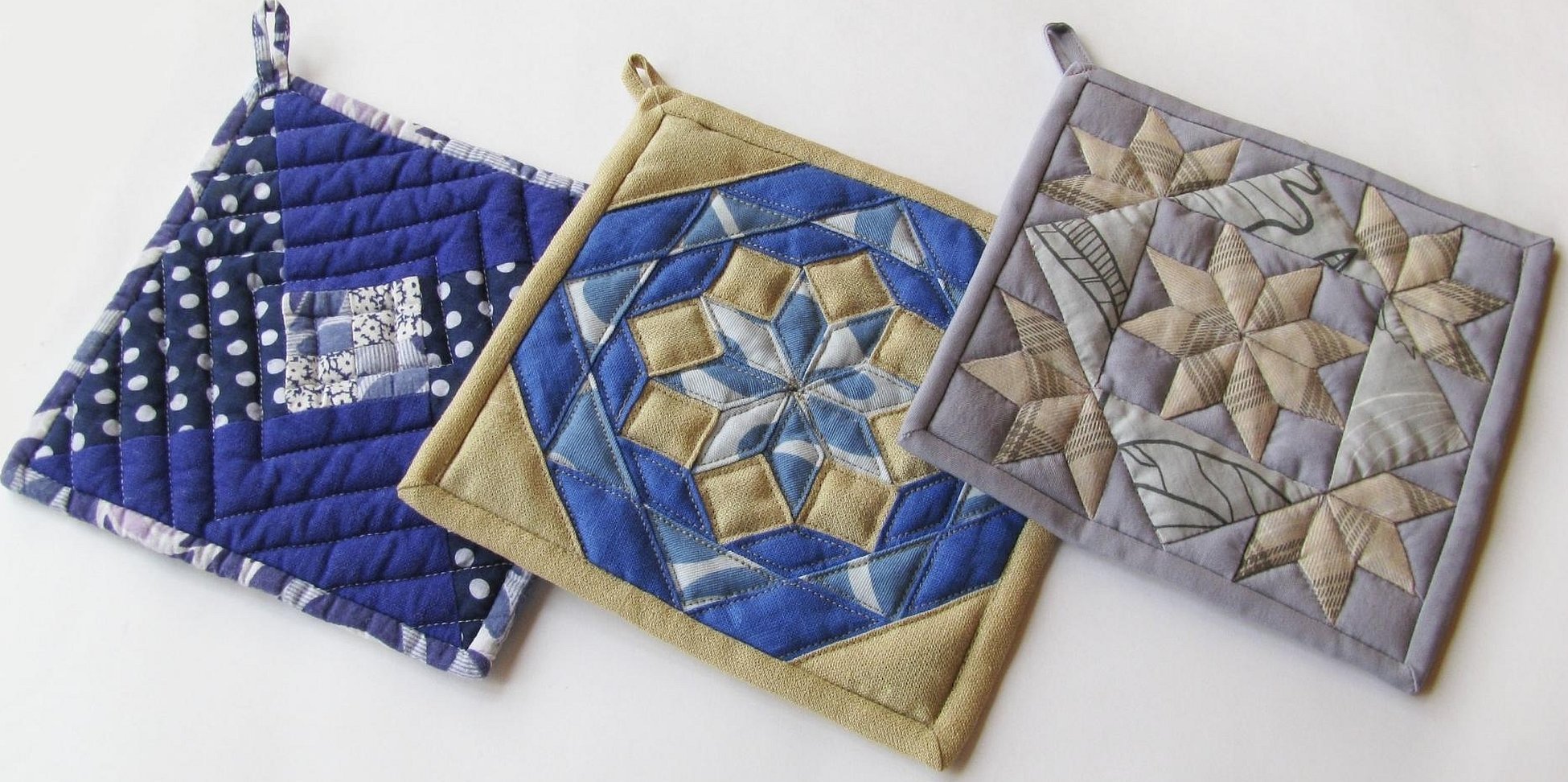
Step by step process:
- The square shape pattern is made 20*20 cm.
- It is transferred to the fabric, leaving 1 sec on the edges for allowances. A total of 4 pieces - 2 external, 2 internal parts.
- The outer ones are placed face to face and the filler is placed on them.
- The seams are stitched, leaving space for turning.
- After the grip is turned inside out, the edges are finished with tape and a loop is sewn on.
"Butterfly"
The life-size butterfly potholder pattern has its own peculiarity - it is made specifically so that it can be put on only the fingers. The recess is not deep, and when moving the fingers located in the "butterfly", you can catch the flapping of its wings. With it, no burns of fingers and palms are scary.
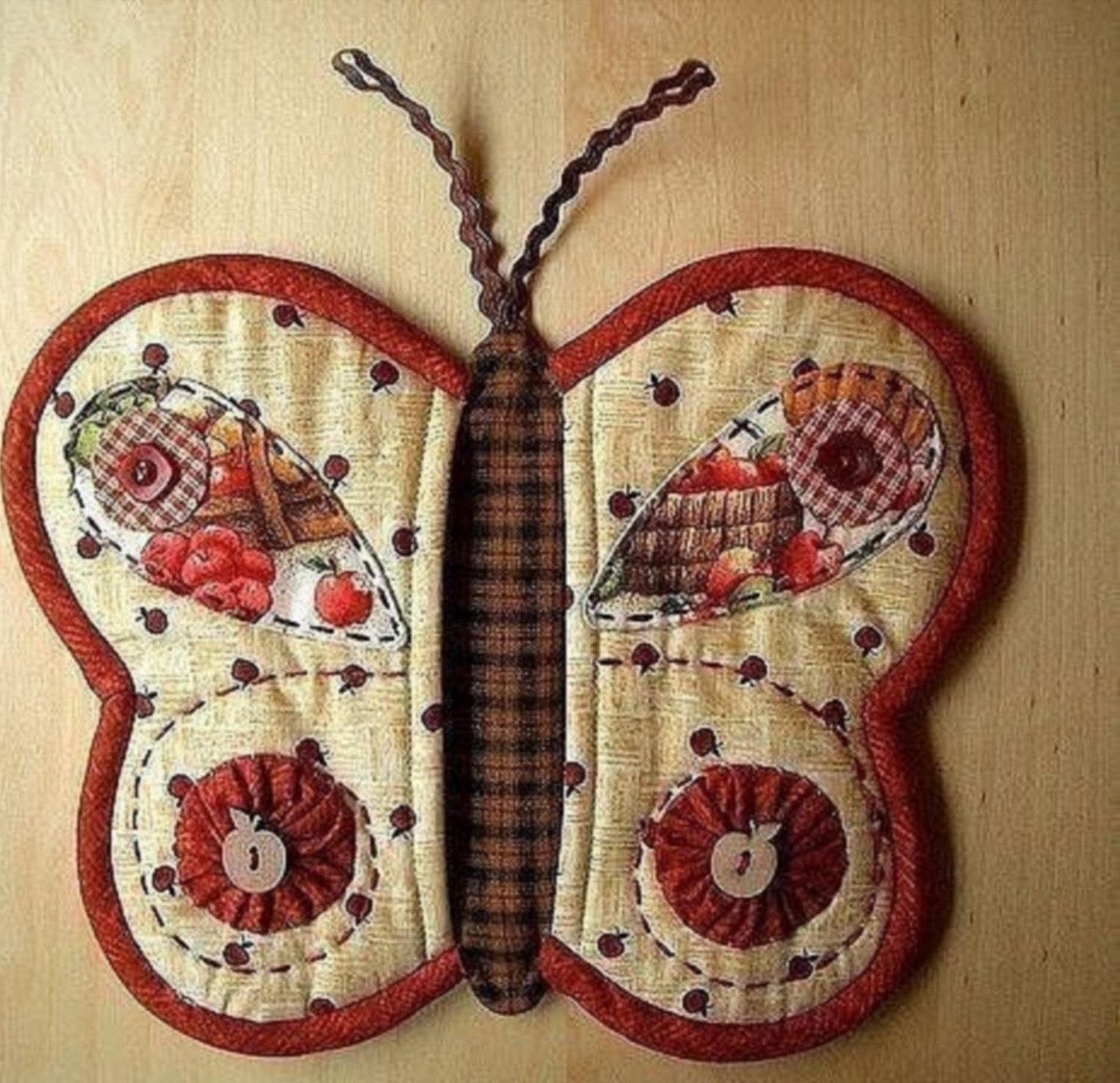
Additional information! After many housewives have tried this type of potholder in everyday life, most of them no longer return to the classic options.
It can also be made in the form of an apple, laying hens, or an egg - the technology is the same, as is the subsequent application. Simple "eggs" are often used as decoration for a festive table.
"Mouse"
When we sew amazing potholders in the shape of a "mouse", an association with the agility of this wonderful little animal always arises. It is not surprising that there are such ideas: a mouse runs quickly, just as hot utensils quickly leave a burn.
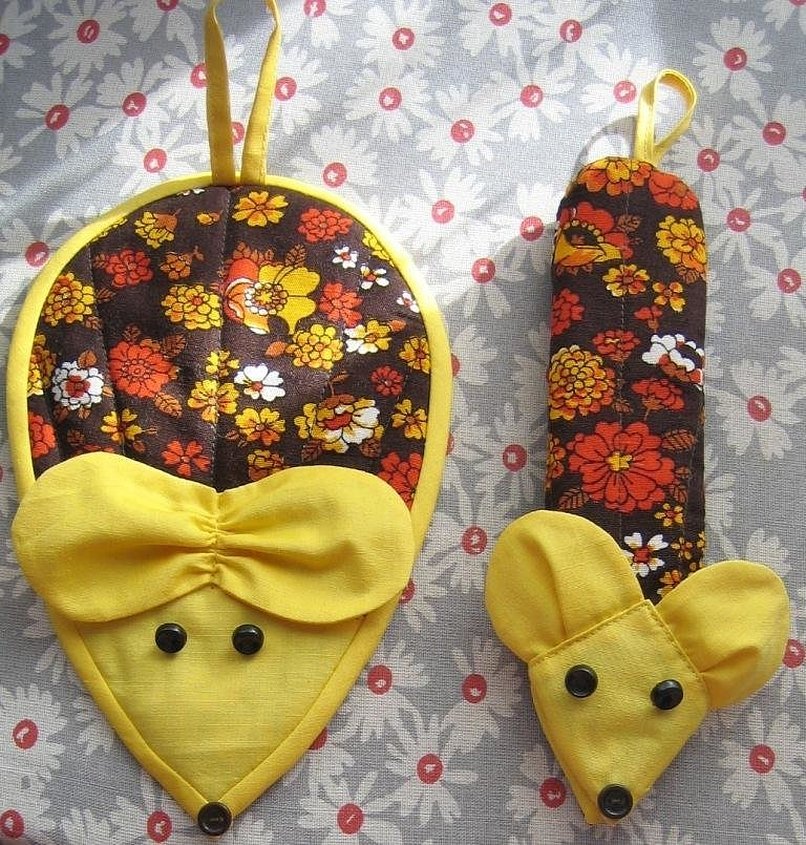
The pattern of the parts is provided below. But it is worth considering some tips:
- The fabric must be non-synthetic, but natural, to avoid sticking to hot dishes.
- The inner layer, the filler, should be significant. The best option is leafy synthetic padding. Alternatively, if you have terry towels or old sweatshirts at home, you can also use them.
- The piping is done using bias binding made of fabric in contrasting shades.
"Glove"
In patchwork sewing, potholders are often shaped like mittens. This is a very common shape.
The materials you will need are:
- Fabric, filler,
- Scissors, threads, needles,
- Sewing machine,
- Braid,
- Pencil and tracing paper.
The creation mechanism is no different from those described above. The pattern sizes are shown in the picture. Tracing paper is needed to immediately transfer the drawing on paper to the fabric.
Square Patchwork Potholder
When creating potholders with your own hands from fabric with patchwork patterns, you can use fabrics of different shades. It all depends on what colors prevail in the kitchen. If beige, caramel or gray, then pastel colors are taken. However, brighter options are also appropriate and often used. Especially, in the ensemble of a decorative element, such as a painting, a vase.
The materials are simple:
- 2 pieces of linen fabric 24*24 cm.
- 24 strips of the same fabric 2.5*24 cm.
- 2 pieces of wool or cotton batting 24*24 cm.
- Take 25 cm of border (so that it matches the main fabric). You can also make it yourself.
- And, of course, scissors, needles, iron, thread, sewing machine—all the tools at hand.
Linen fabric is placed under the batting, and strips are placed on top, which will need to be sewn to the batting. Two strips are placed next to each other, folded in the center of the main part, sewn on one side. The top strip will then need to be folded back and the seam ironed.
Important! The stripes should be facing the seamstress.
Then take another strip, put it on top of the ironed one and sew it on using the same principle, and finally turn it over and iron it. As a result, the part should be completely covered with strips. Do the same with the second main fabric. Then sew the border on these strips. The raw edge of the border must be connected to the raw edge of the potholder. First, it is sewn to one side of the potholder from one corner, and before each new corner, the border is folded by 24 degrees. The result is that it is stitched along the entire perimeter.
At the end, it is worth returning to the starting corner and bending the border to the front side. Then, pinning it with pins, the tip becomes a "loop", and the remainder is tucked inside.
The finishing touch is to sew the border to the front side.
In fact, in practice it is worth trying just once - and the patchwork style will seem the simplest of all.
DIY Potholder from Old Jeans Remnants
Some grab handles are even made from the fabric of old curtains or jeans. Why you should choose denim material:
- It is always available. Surely, every housewife has old worn-out jeans that are gathering dust in the closet.
- Very dense, thick fabric will not allow you to get burned.
- The material is natural, so it does not melt, does not stick, and holes and damage rarely form on it.
- It is easy to wash and does not require ironing, as it hardly wrinkles.
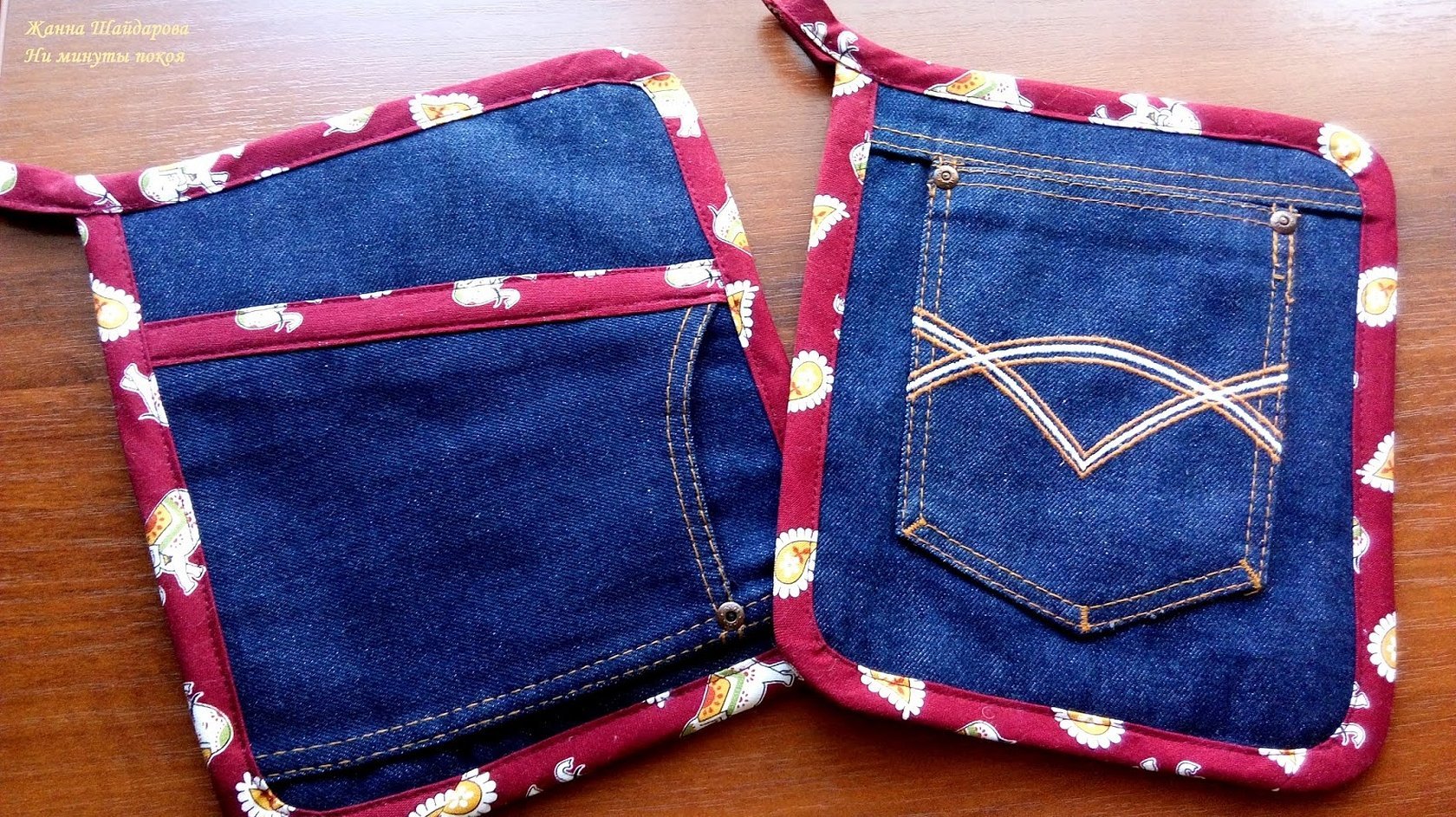
As for how to sew potholders from such material: absolutely any housewife can do it! It is enough to turn on your fantasy and imagination. Even if you did not have the opportunity to sew before or somehow did not succeed, then such details will make you raise your self-esteem and learn needlework and sewing skills.
You can safely choose the shape - a circle, a square, or maybe animals or insects? Just try it once - and you can create a whole collection of your own brand.
How to sew a potholder from scraps
As is known, the patchwork style was used by our ancestors. Its advantage is that when creating it, fabrics of unnecessary, old things of absolutely any kind are used. And this adds piquancy to the thing - interesting simple patterns or small, extraordinary details remain.
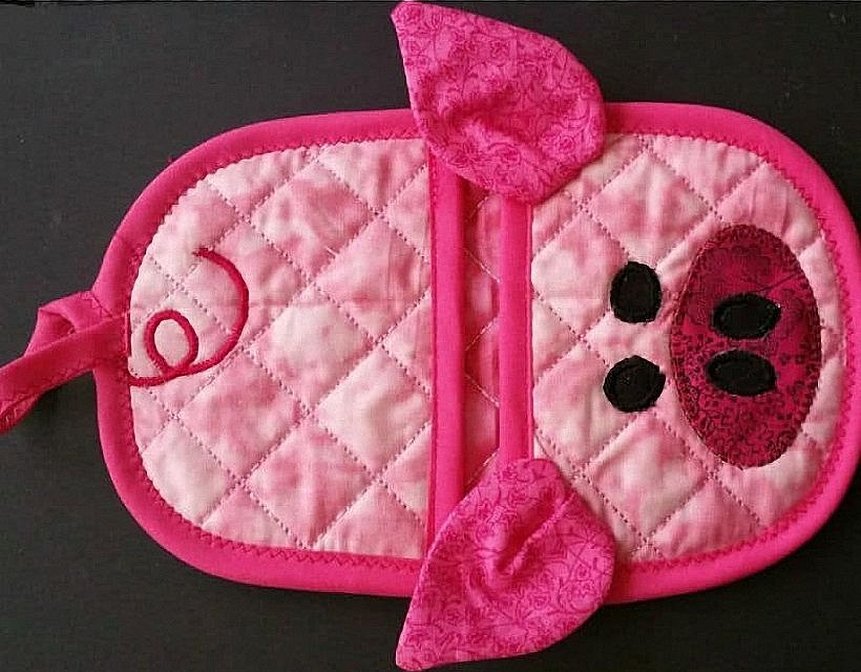
The process itself is not complicated, but it is quite labor-intensive - it requires a lot of attention, concentration and precision in execution.
Below is a short master class on how to create a potholder from scraps.
Materials:
- 4 pieces of fabric (inner and outer parts) 24*24 cm.
- Strips 2.5*24cm.
- Binding for edging.
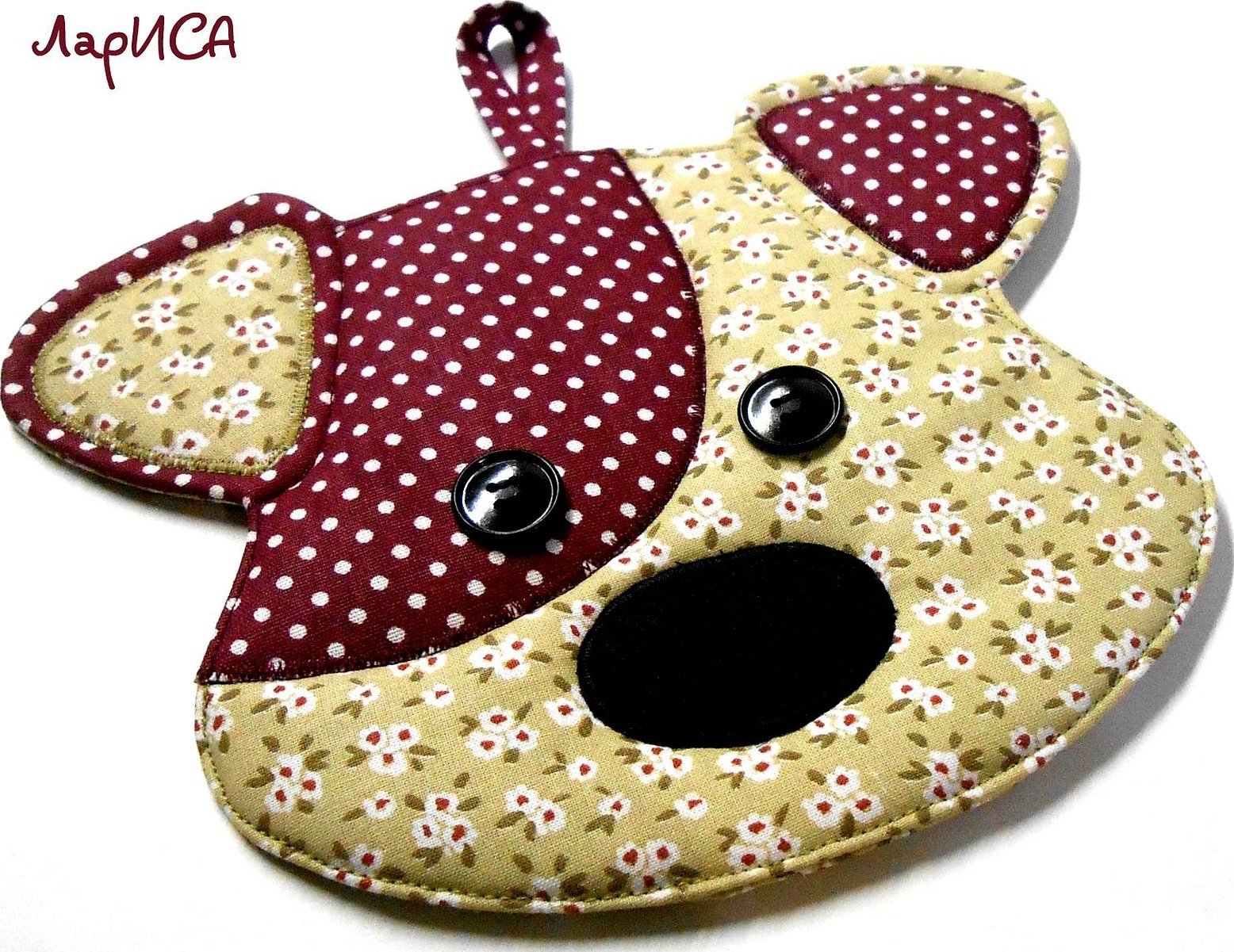
Scheme:
- Take a piece of the main fabric (outer), place the filling (inner piece) on it and start sewing the strips to the squares.
- Two shelves are stitched face to face to the base on one side. Turned back, ironed. The next strip is applied and stitched to the grab, turned back and ironed.
- The surface should be filled with stripes.
- The binding is applied to the wrong side and secured around the entire perimeter. At each corner it should be bent at an angle of 25 degrees.
- The piping is sewn onto the potholder, leaving space for the loop.
- Now it should be turned to the front side, secured with pins and light stitches.
- The remaining part of the piping will serve as a loop, and the “tail” can be hidden inside.
- The final stage: the piping is sewn to the grip.
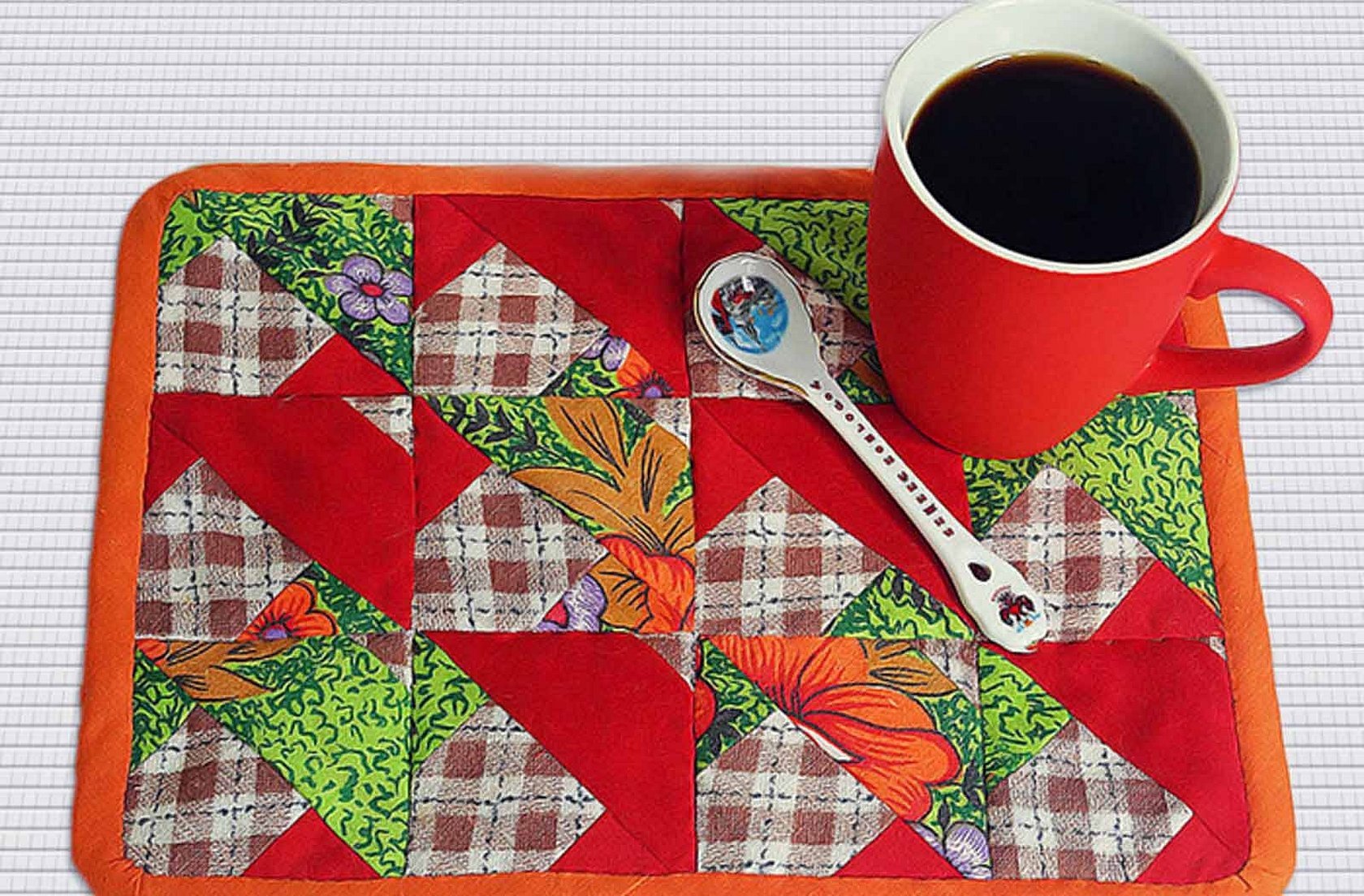
When making items with your own hands, you can choose the shape yourself: apple, Christmas tree, heart, owl, pig, nesting doll, fruit. The flow of human imagination is limitless. Potholders with patterns are not difficult to find on the Internet, and, following the patterns, create your own set of original accessories, which will include both mittens and figured items that match the color scheme of the interior.




